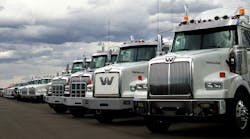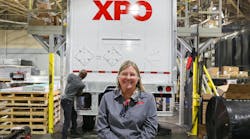At the halfway point of a two-week summer road test conducted by Freightliner LLC engineers, over half a dozen of the company's truck products are trundling up and over the 11,900-ft. Continental Divide at Loveland Pass, CO.
Onboard computers record in minute detail between 75 and 100 individual streams of data, including engine temperature, road speed and fan on/off time, all in an effort to gain insight into the issues facing truck OEMs as the 2007 emission deadline draws closer.
“The real focus of our summer tests this year is to gain more knowledge about the performance and cooling needs of 2002 and 2004 emission-compliant engines so we can apply what we learn to what's facing us in 2007,” says Ramin Younessi, chief test engineer for Freightliner. “We're also looking at HVAC performance and the integration issues between the engine and transmission, and how those two factors will impact what may happen in 2007.”
Journalists invited by Freightliner to join part of the two-week summer test last July traveled from Rock Springs, WY, to Frisco, CO, and then spent a day at Loveland Pass, CO, as Freightliner's test engineers drove several different configurations — two Columbia, a Century Class and two Western Star sleepers, a Sterling day cab tractor and straight truck, plus two Business Class M2 straight trucks — pulling fully loaded dry van and tanker trailers over Loveland Pass to record high-altitude performance data.
“Getting real-world road mileage under these conditions is extremely important for our ‘07 research,” Younessi explains. “We're also fine-tuning our current models as we record and examine temperature and cooling flow, looking at threshold points we'll need to watch under heavy load situations.”
As he nonchalantly guides one of the Western Star sleepers into the teeth of a violent Wyoming thunderstorm, complete with lightning and hail the size of golf balls, Matt Markstaller, manager of vehicle performance testing, explains that planning for the summer test starts in February because it takes about four months to build the trucks and wire them for data collection.
“This road trip is only one of 1,550 laboratory and real-world tests we conduct to qualify that a complete vehicle and its components are ready for production,” he points out.
Markstaller says new truck designs and their components first go through a series of mechanical and electrical component tests that evaluate metal fatigue, frame deflection, corrosion, structural and thermal stability. In addition, they look at how sensors designed to record and transmit data, — located in the ABS or transmission, for example — hold up under the harsh conditions expected out on the road.
“We then move on to integration testing, which involves putting prototype vehicles through performance tests at our proving ground in South Bend, IN, with both engineers and professional drivers at the wheel,” he explains. “It's part of making sure the vehicle and its parts will be durable over a lifecycle of a million miles. That's why we're also doing accelerated durability testing in the laboratory at the same time.”
In addition to the summer and winter road tests, Freightliner has 12 company-owned fleet test trucks running legitimate freight between its Portland, OR, and Charlotte, NC, factories. These vehicles accumulate 285,000 miles a year as part of a long-term mileage evaluation testing program. On top of that, says Markstaller, the company places over 900 test trucks in the field with customers such as U.S. Xpress Enterprises to get insight into how its products are used and hold up in the commercial trucking environment.
“Road tests give you a chance to see and catch things you might not notice in the laboratory or on the test track,” he adds. “It's a very different experience when you, as an engineer, go out for two weeks on the road driving these trucks 10 hours a day, versus spending maybe one or two hours behind the wheel at the proving grounds.”
Collecting the test data is not easy, either. Jim Martin, a development test engineer, is in charge of downloading all the data collected by the special onboard computers mounted in each vehicle either twice a day or after a specific vehicle run, such as a single trip up and over the Loveland Pass. His day typically begins at 5:30 a.m. when he gets the computers up and running, and ends at 9 p.m. or later when the trucks are parked for the night.
Martin says that almost 3,000 feet of wire is needed to link up the computers on each truck with all of the sensors collecting data throughout the vehicle. “That's why it takes so much time to prep these vehicle for the summer test,” he explains.
The onboard computers, which are the size of small suitcases, are bolted to the floor of the cab and tend to take up space used for, among other things, arm rests and cup holders — much to the dismay of the engineers behind the wheel.
The second half of Freightliner's summer test takes place in Laughlin, NV, where the trucks operate up a 6% grade that's 12 miles long in temperatures ranging between 110 and 120 degrees F. Not only do those tests involve a variety of experimental technology, they also test de-rating, one potential strategy for handling the higher heat loads generated by 2002 low-emission engines and those on the horizon.
“The cooling system can handle only so much heat, so under extreme loads we're looking at de-rating the engine in increments to reduce the chances of overheating,” Younessi says. “That involves reducing the available horsepower slowly. The rule of thumb is that you can reduce available horsepower by about 10% before the driver notices it. Our goal is to see how much and how smoothly we can reduce it so the driver doesn't feel it.”


